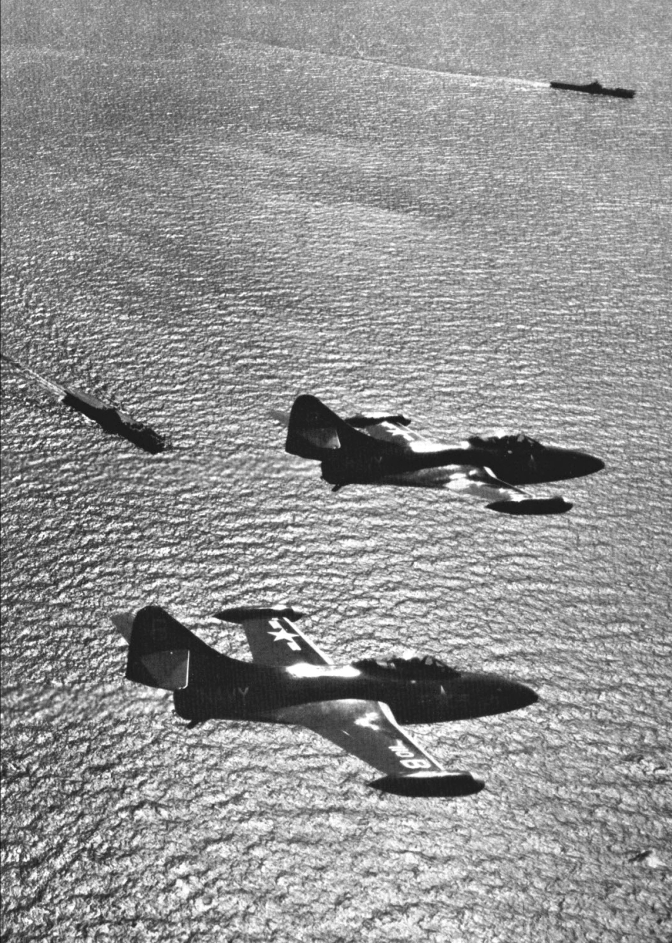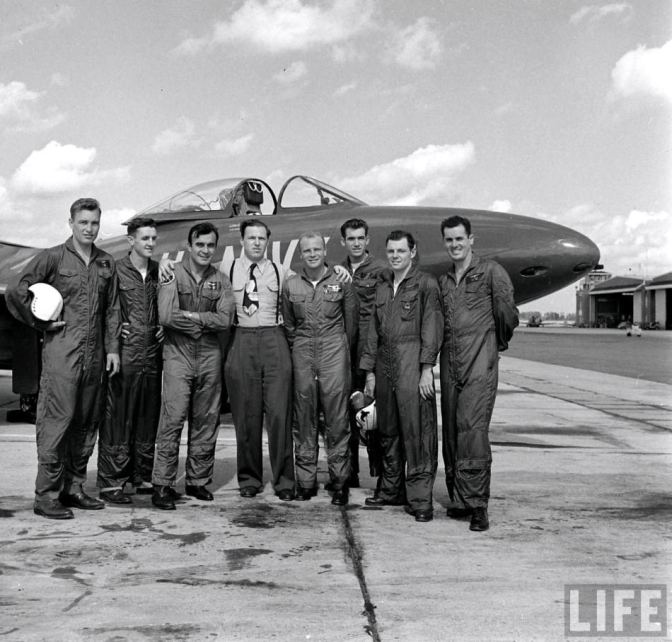Mid-1949, Lieutenant Commander Johnny Magda was given orders to report to Naval Air Station Whiting Field in central Santa Rosa County, Florida. The decorated naval aviator, a fighter ace who survived a five-day stint in an inflatable raft with another downed aviator before being rescued, was assigned to the Blue Angels, the Navy’s relatively new flight demonstration group, where he would rise to become the team’s commanding officer the very next year. On the other side of the world, the situation across the 38th parallel was rapidly deteriorating, with two Korean governments claiming to be the sole legitimate governing body of Korea. By June of 1950, war had broken out and the United Nations, as well as a number of its member states, took action immediately. Back in the United States, the Navy and government contractors scrambled to bring mothballed ships back into service for deployment overseas including the USS Princeton, an Essex-class straight-deck aircraft carrier
Responsible for leading the team’s very first jet exhibition flight, flying the Grumman F9F-2 Panther in front of a sizable crowd of onlookers at Beaumont, Texas, Magda was every bit the consummate and professional pilot his previous superiors claimed he was. His assignment with the Blues was not to last, however. When mid-1950 came around, the Department of the Navy made the decision to dissolve the Blue Angels team when all pilots volunteered for combat duty. Chief of Naval Operations Admiral William Fechteler then ordered that the Blues return all their aviators to active flight duty. This was a fairly decent idea on the part of higher ranking officers, especially as the majority of Blue Angels pilots came from carrier-based fighter squadrons deployed throughout the Pacific Theater during WWII. They would be able to function as both leaders to newer aviators who would replace the scores of former pilots who had resigned their commissions after 1945, and as an efficient, experienced and versatile aerial strike team. As an added bonus, Navy public relations would get a significant positive boost because of the willingness of the demonstration pilots to reenter the fight of their own volition.
LCDR Magda, along with Lieutenant Arthur Ray Hawkins, the Navy’s 10th leading ace of WWII and a current Blues pilot, were reassigned to Fighter Squadron 191 (VF-191), known as “Satan’s Kittens”. Magda would function as Commanding Officer of VF-191, while Hawkins would be his Executive Officer, the second-in-command; the remaining Blues pilots would join them there as well. VF-191 would be assigned to Air Group 19, which in turn was attached to the recently re-commissioned USS Princeton. The plan called for the carrier to steam to the Korean coast where it would link up with Task Force 77 to launch jet combat air patrols, support Marines on the ground who were fighting their way from Chosin to Hungnam, and to effect airstrikes on Chinese and North Korean positions. For the first time in its history, the Blue Angels were off to war.
After concluding their last airshow of the shortened 1950 season at Dallas on July 30th, the team packed up and flew out the very next day to San Diego to deliver their jets, and then reported to NAS Moffett Field in San Francisco. They were immediately processed in and were shown their new assigned aircraft. Satan’s Kittens would be flying F9F-2B Panthers, essentially the same aircraft they flew in their previous incarnation as Blues demonstrators. However, these jets were heavier with a slightly reduced range, thanks to the inclusion of weaponry that was otherwise stripped from the demonstrators. Time was of the essence, and as VF-191 was composed mostly of F8F Bearcat propeller pilots who had just returned from a cruise aboard the USS Boxer, Magda and Hawkins had to get their pilots ready to rock within just a few months before their carrier was scheduled to deploy. Between late August and mid-October, the former Blues pilots led the rest of VF-191 in getting checked out in the F9F-2B, and between October 16th and the 20th, were able to perform successful carrier qualifications aboard the Princeton off the Southern Californian coast. On November 7th, VF-191 took their aircraft over to NAS Alameda where the Princeton was berthed and awaiting the order to move out. Panthers were loaded by crane aboard the flattop, and the ship steamed for Hawaii, en route to Korea, where the squadron’s pilots were now waiting to join the ship on its cruise.

Over the course of their combat cruise, VF-191 took part in a number of combat air patrol missions over Korea and effected a number of successful air-to-ground operations in support of Marines fighting communist on the cold, hilly terrain. Since this would be the first time many of the air wing and ship’s crew aboard the Princeton had deployed with jets, they were still getting accustomed to the transition from propellers. The slightest reasons, including not enough wind across the bow, would lead to the cancellation of jet operations in favor of propeller birds. Retired CDR. Jack “Jake” Robcke, a former Blue and VF-191 aviator who shipped out with Magda and Hawkins, would later recall:
“Korea, for the first cruise, was not all that exciting … We had an excellent ship, the Princeton, although they were a little afraid of the airplanes … They did not know what to do with us really. We flew a lot of CAP and frankly did not do much flying at all.”
Regardless, they were still flying in harm’s way. In March of 1951, VF-191 was stunned when word got back to the carrier that a Panther wouldn’t make it back. Johnny Magda, leading a low-level strike with rockets and guns on communist infantry positions, was hit with anti-aircraft fire. Pulling out of the strafing run, his wingmen saw his jet spew smoke and then light ablaze. He nursed the mortally wounded aircraft out to sea, near Tachnon on Korea’s east coast, but tragically, it went down and Magda was lost. He was awarded the Navy Cross, the Navy’s second highest medal for valor and bravery (to the Medal of Honor).
In 1951, the Blue Angels were stood up once more as the Navy’s sole flight demonstration team, flying the F9F-5 Panther. They never were returned to combat duty again.


Nice post thanks for shaaring
LikeLike